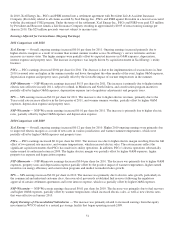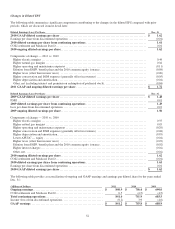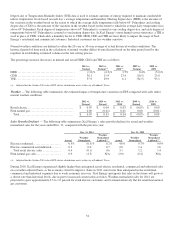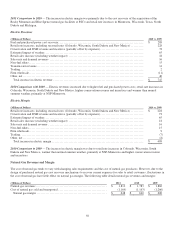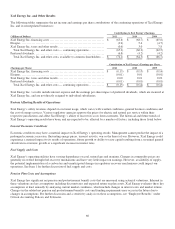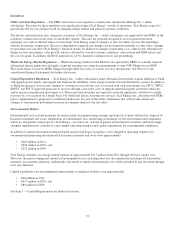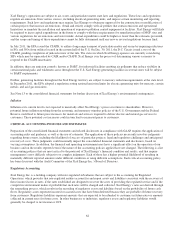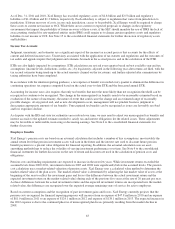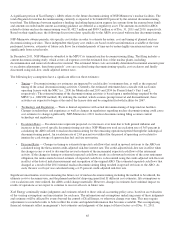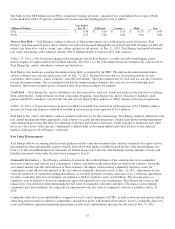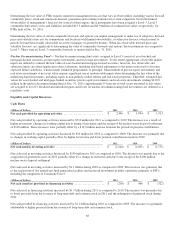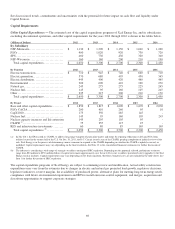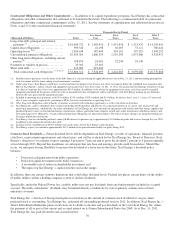Xcel Energy 2011 Annual Report Download - page 71
Download and view the complete annual report
Please find page 71 of the 2011 Xcel Energy annual report below. You can navigate through the pages in the report by either clicking on the pages listed below, or by using the keyword search tool below to find specific information within the annual report.61
Regulation
FERC and State Regulation — The FERC and various state regulatory commissions regulate Xcel Energy Inc.’s utility
subsidiaries. Decisions by these regulators can significantly impact Xcel Energy’s results of operations. Xcel Energy expects to
periodically file for rate changes based on changing energy market and general economic conditions.
The electric and natural gas rates charged to customers of Xcel Energy Inc.’s utility subsidiaries are approved by the FERC or the
regulatory commissions in the states in which they operate. The rates are generally designed to recover plant investment,
operating costs and an allowed return on investment. Xcel Energy requests changes in rates for utility services through filings
with the governing commissions. Because comprehensive general rate changes are not requested annually in some states, changes
in operating costs can affect Xcel Energy’s financial results. In addition to changes in operating costs, other factors affecting rate
filings are new investments, sales growth, which is affected by overall economic conditions, conservation and DSM efforts and
the cost of capital. In addition, the ROE authorized is set by regulatory commissions in rate proceedings.
Wholesale Energy Market Regulation — Wholesale energy markets in the Midwest are operated by MISO to centrally dispatch
all regional electric generation and apply a regional transmission congestion management system. NSP-Minnesota and NSP-
Wisconsin expect to recover MISO charges through either base rates or various recovery mechanisms. See Note 12 to the
consolidated financial statements for further discussion.
Capital Expenditure Regulation — Xcel Energy Inc.’s utility subsidiaries make substantial investments in plant additions to build
and upgrade power plants, and expand and maintain the reliability of the energy transmission and distribution systems. In addition
to filing for increases in base rates charged to customers to recover the costs associated with such investments, the CPUC, MPUC,
SDPUC and PUCT approved proposals to recover, through a rate rider, costs to upgrade generation plants and lower emissions,
and/or increase transmission investment cost. These non-fuel rate riders are expected to provide significant cash flows to enable
recovery of costs incurred on a timely basis. For wholesale electric transmission services, Xcel Energy has, consistent with FERC
policy, implemented or proposed to establish formula rates for each of the utility subsidiaries that will provide annual rate
changes as transmission investments increase in a manner similar to the rate riders.
Environmental Matters
Environmental costs include payments for nuclear plant decommissioning, storage and disposal of spent nuclear fuel, disposal of
hazardous materials and waste, remediation of contaminated sites, monitoring of discharges to the environment and compliance
with laws and permits with respect to Xcel Energy’s air emissions. A trend of greater environmental awareness and increasingly
stringent regulation may continue to cause, higher operating expenses and capital expenditures for environmental compliance.
In addition to nuclear decommissioning and spent nuclear fuel disposal expenses, costs charged to operating expenses for
environmental monitoring and disposal of hazardous materials and waste were approximately:
• $265 million in 2011;
• $256 million in 2010; and
• $225 million in 2009.
Xcel Energy estimates an average annual expense of approximately $317 million from 2012 through 2016 for similar costs.
However, the precise timing and amount of environmental costs, including those for site remediation and disposal of hazardous
materials, are currently unknown. Additionally, the extent to which environmental costs will be included in and recovered through
rates may fluctuate.
Capital expenditures for environmental improvements at regulated facilities were approximately:
• $48 million in 2011;
• $473 million in 2010; and
• $89 million in 2009.
See Item 7 — Capital Requirements for further discussion.


